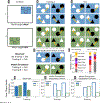As within, so without, as above, so below: Common mechanisms can support between- and within-trial category learning dynamics
- PMID: 35849355
- PMCID: PMC10321570
- DOI: 10.1037/rev0000381
As within, so without, as above, so below: Common mechanisms can support between- and within-trial category learning dynamics
Abstract
Two fundamental difficulties when learning novel categories are deciding (a) what information is relevant and (b) when to use that information. Although previous theories have specified how observers learn to attend to relevant dimensions over time, those theories have largely remained silent about how attention should be allocated on a within-trial basis, which dimensions of information should be sampled, and how the temporal order of information sampling influences learning. Here, we use the adaptive attention representation model (AARM) to demonstrate that a common set of mechanisms can be used to specify: (a) How the distribution of attention is updated between trials over the course of learning and (b) how attention dynamically shifts among dimensions within a trial. We validate our proposed set of mechanisms by comparing AARM's predictions to observed behavior in four case studies, which collectively encompass different theoretical aspects of selective attention. We use both eye-tracking and choice response data to provide a stringent test of how attention and decision processes dynamically interact during category learning. Specifically, how does attention to selected stimulus dimensions gives rise to decision dynamics, and in turn, how do decision dynamics influence which dimensions are attended to via gaze fixations? (PsycInfo Database Record (c) 2022 APA, all rights reserved).
Figures











Similar articles
-
Distributed Neural Systems Support Flexible Attention Updating during Category Learning.J Cogn Neurosci. 2022 Sep 1;34(10):1761-1779. doi: 10.1162/jocn_a_01882. J Cogn Neurosci. 2022. PMID: 35704551
-
"The eyes are the window to the representation": Linking gaze to memory precision and decision weights in object discrimination tasks.Psychol Rev. 2024 Jul;131(4):1045-1067. doi: 10.1037/rev0000475. Epub 2024 May 16. Psychol Rev. 2024. PMID: 38753387 Free PMC article.
-
Temporal characteristics of overt attentional behavior during category learning.Atten Percept Psychophys. 2013 Feb;75(2):244-56. doi: 10.3758/s13414-012-0395-8. Atten Percept Psychophys. 2013. PMID: 23151960
-
Understanding active sampling strategies: Empirical approaches and implications for attention and decision research.Cortex. 2018 May;102:150-160. doi: 10.1016/j.cortex.2017.08.019. Epub 2017 Aug 24. Cortex. 2018. PMID: 28919222 Free PMC article. Review.
-
View-invariant object category learning, recognition, and search: how spatial and object attention are coordinated using surface-based attentional shrouds.Cogn Psychol. 2009 Feb;58(1):1-48. doi: 10.1016/j.cogpsych.2008.05.001. Epub 2008 Jul 23. Cogn Psychol. 2009. PMID: 18653176 Review.
Cited by
-
Cognition: The power of simple associative learning.Curr Biol. 2023 Mar 27;33(6):R223-R225. doi: 10.1016/j.cub.2023.01.062. Curr Biol. 2023. PMID: 36977383 Free PMC article.
-
The Role of Attention in Category Representation.Cogn Sci. 2024 Apr;48(4):e13438. doi: 10.1111/cogs.13438. Cogn Sci. 2024. PMID: 38605457 Free PMC article.
-
Cognitive Inertia: Cyclical Interactions Between Attention and Memory Shape Learning.Curr Dir Psychol Sci. 2024 Apr;33(2):79-86. doi: 10.1177/09637214231217989. Epub 2024 Jan 19. Curr Dir Psychol Sci. 2024. PMID: 40535114 Free PMC article.
-
The quest for simplicity in human learning: Identifying the constraints on attention.Cogn Psychol. 2022 Nov;138:101508. doi: 10.1016/j.cogpsych.2022.101508. Epub 2022 Sep 21. Cogn Psychol. 2022. PMID: 36152354 Free PMC article.
-
Examining the Relationship Between Early Experience, Selective Attention, and the Formation of Learning Traps.Cogn Sci. 2025 May;49(5):e70070. doi: 10.1111/cogs.70070. Cogn Sci. 2025. PMID: 40411818 Free PMC article.
References
-
- Allport A, Styles E, & Hsieh S (1994). Shifting intentional set: Exploring the dynamic control of tasks. In Umilta C & Moscovitch M (Eds.), Attention and performance xv: Conscious and nonconscious information processing (p. 421–452). Cambridge, MA: MIT Press.
-
- Anderson J (1991a). The adaptive nature of human categorization. Psychological Review, 98, 409–429.
-
- Anderson J (1991b). Is human cognition adaptive? Behavioral & Brain Sciences, 14, 471–484.
Publication types
MeSH terms
Grants and funding
LinkOut - more resources
Full Text Sources
Research Materials

